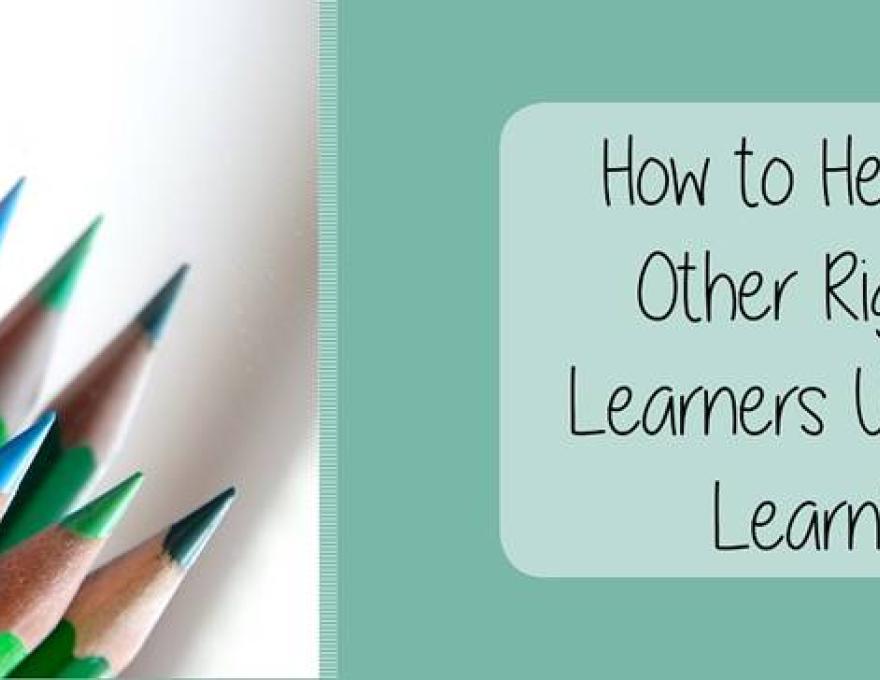Frequently when parents call to talk about their child’s learning needs, they tell me that their child is struggling, but then the quickly follow that by telling me how very bright their child is. Often I sense that the parent is expecting me to doubt their word that their child is bright, but that is never my response.
I know first-hand how capable and bright visual learners are. It is not their brain or their lack of talent that is to blame for their struggles in school. What I have come to understand is that the culprit is the mismatch between a visual learner’s gifts and the design of the lesson and materials used.
Visual learners have specific gifts for learning, and once they understand their own strengths, they will be able to help themselves all through their years in school. Following are some areas of strength for visual learners.

THEY CAN SEE LEARNING CONCEPTS IN PICTURES IN THEIR HEADS
o This skill/ability of right-brained or visual learners is the most powerful gift they have but also the hardest for adults to accept or utilize with confidence. We, as adults, are habituated toward doling out little tidbits of learning in a prescribed order, in a linear, sequential manner – that is directly opposed to how these children learn.
o Teaching children the letter sounds and then trying to get them to sound out words based on phonics rules they have been taught. This particular topic is the downfall of so many visual, right-brained learners. They just stumble along and don’t ever get into really reading when they are approached this way.
o Teaching children math facts that they need to memorize. Using flashcards to repeatedly drill with the goal of building fluency with their math facts.
o Giving children a list of spelling words to memorize for a test. Spelling words consist of groups of letters in a particular sequence that the child will have to chant repeatedly in hopes that the sequence of letters will remain in their brains long enough to last through the spelling test.
o Giving children lists of sight words to memorize in order to speed up their reading… and because sight words are supposedly words that are not easy to sound out.
o Teaching children math or phonics rules that they will need to apply to specific situations as they do their seat work or homework.
None of those topics mentioned above can be translated by a visual learner into pictures she can see, snap a mental picture of, and recall intact later. Not unless the child has been taught specifically how to order their learning material in such a way that their right-brained self can absorb it successfully.
It makes a lot of sense for the adult teacher to embed the learning concepts in visuals that will be the means of a child learning the concepts she needs to learn.
THEY REMEMBER BEST WHEN NEW INFORMATION IS ARRANGED IN A MEANINGFUL PATTERN
For children that struggle with reading in regular schools, the knee-jerk reaction is to make their body of learning much smaller. But this is really the opposite of what works with these students.
For instance, in my Title 1 2nd grade classroom, I had a group of non-readers. Each time we met, we had a list of words (about 10) that they were supposed to learn. I would select a list of words that had something in common such as a long vowel spelling.
Now, instead of teaching the children to recognize each word (which they obviously could not do) we focused on the common element. The EA spelling in each word allowed the words to be written in a way that the children could detect the pattern in the words. We would highlight the EA so that visually it stood out. These kids would see those words with the EA spelling pattern in common on their papers and it helped them learn and remember how to spell and read those words.
So with these children, while I began with their 8-10 words, I would always add more and more words that followed the same pattern to their list. If they could write 8 words using the spelling pattern EA, they could write 20 or 30.
AN EXAMPLE OF TEACHING WITH PATTERNS
To give a more example of this, say the students’ spelling list is: nail, fade, back, came, bank, hail, wade, lame, rank, sack. First, I would put words in pairs that are similar: Nail/hail, fade/wade, back/sack, bank/rank, came/lame. We have the tiny beginnings of a good right-brained lesson that utilizes patterns.
Start with the first pair of words, and rather than say, “This word says NAIL. N, A, I, L. Spell it with me, copy it on your paper, memorize it.” I would say, “The AI in this word says Long A. You can find AI in both NAIL and HAIL. Take your yellow highlighter and color the AI in those words.”
Next, I would have created a list of several other words for them to add that also had the same AI spelling: mail, fail, rail, sail, tail, bail. These would be added to the column of AI words and their common spelling pattern would also be highlighted yellow.
What you have now is a whole column of words with yellow "aIs." What this creates for the child is a whole pattern that they can visually snap into their memories. They are learning the spelling pattern by sight. The "al" in each word is the core or the foundation to which a few other sounds are added.
Then, I would take the next pair of words and do the same thing, this time highlighting the sound spelling the words have in common.
THEY REMEMBER WELL WHEN NEW INFORMATION IS TIED TO SOMETHING KNOWN (STORY, SKIT, METAPHOR)
Children remember novelty: a visual, a jingle, a metaphor. “1 is a thin man standing up straight.” “8 is a snowman, makes me laugh.” “M is mountains.” “S is a snake.”
When I teach digraphs SH, TH, PH, WH, CH, I don’t just say, “CH says ch like in chop.” I tell a story and the kids act it out.
For instance, I might say the following story. The handsome Mr. H walked into town one day. He walked up to a nice yellow house where Miss S lived. He rang her doorbell and when she came to the door, he invited her to come out and walk with him.
Well, Miss S was so excited that instead of being able to say her normal sound, she got all flustered and she and Mr. H together made a brand new sound: “SHHHH.”
CHILDREN WILL LEARN TO HELP THEMSELVES
The first thing to do to help your struggling visual learners is to assure them that they have giftedness that many people don’t have, but we haven’t been using it. They need to have their confidence restored first.
The second thing to do is to use vastly different materials so that the lessons you do with them are totally and utterly different from what they used before.
Finally, just come out and tell them the strengths they have because over time they will learn to transform left-brained content into a format that they can absorb more easily.
Sarah Major, CEO of Child1st Publications, grew up on the mission field with her four siblings, all of whom her mother homeschooled. As an adult, Sarah has homeschooled a small group of children in collaboration with their parents, and has taught from preschool age to adult. Sarah has been the Title 1 director and program developer for grades K-7, an ESOL teacher, and a classroom teacher. As an undergraduate student, Sarah attended Wheaton College in Wheaton, Ill. and then received her M.Ed. from Aquinas College in Grand Rapids, MI. In 2006 Sarah resigned from fulltime teaching in order to devote more time to Child1st, publisher of the best-selling SnapWords™ stylized sight word cards. In her spare time Sarah enjoys gardening, cooking, pottery, quilting, and spending time with her family.
Child1st Publications, LLC
www.child1st.com
800-881-0912






